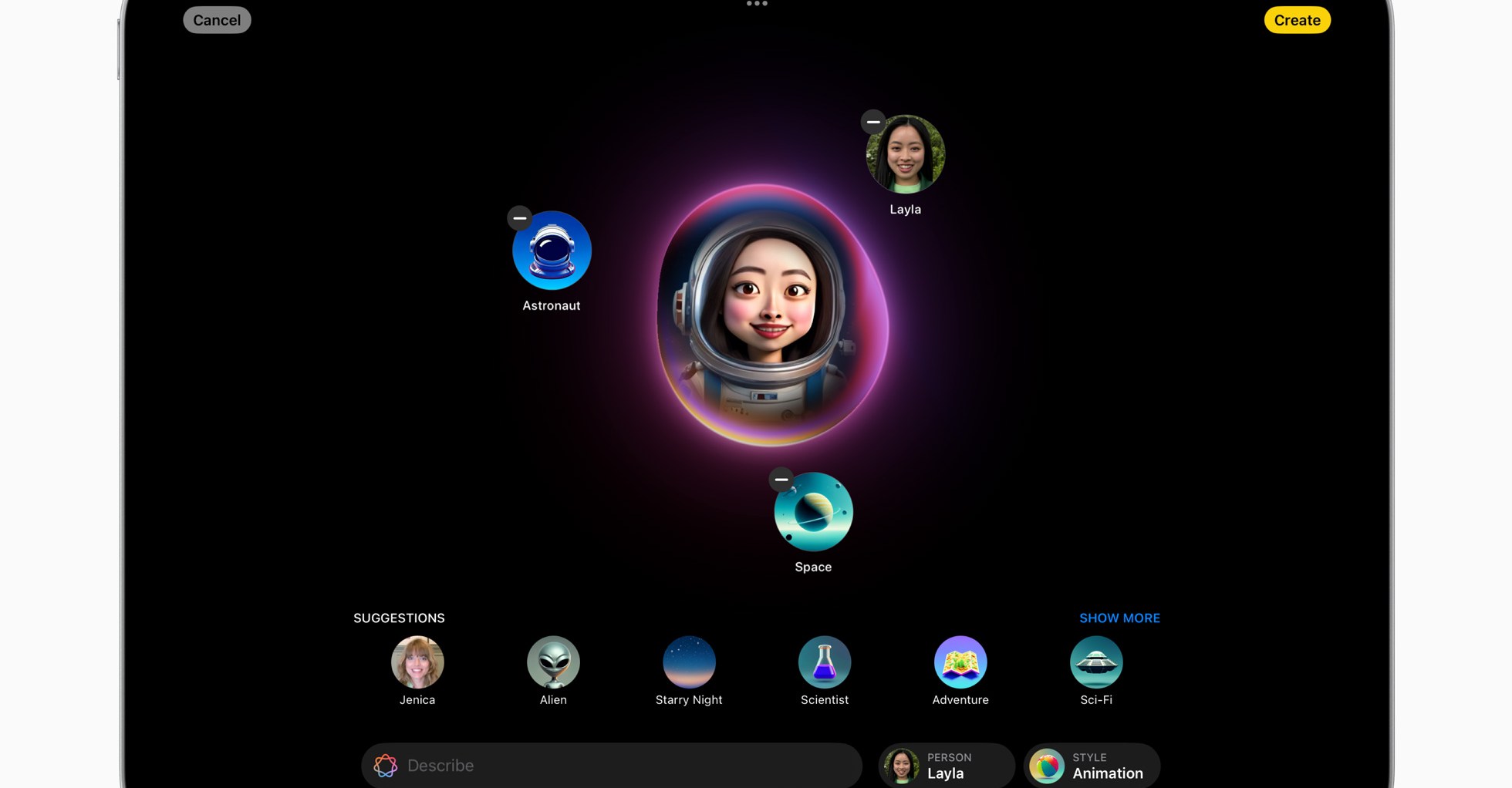
A few months from now, your iPhone will know you too well. You may find yourself talking to it and asking it to find that picture from Easter, the one with the baby wearing a bunny outfit and the dogs dressed like eggs, and to send it to your wife and in-laws. And then Siri will do all of it, without you needing to lift a finger. Thanks to a suite of new AI features coming from Apple, Siri will soon know who your wife and in-laws are, know what’s in all your photos, and will fulfill almost any request you could ask of your iPhone.
This isn’t supposed to be creepy, according to Apple. The company just announced Apple Intelligence, a deeply integrated set of generative AI features that will launch with iOS 18, iPadOS 18, and macOS Sequoia this fall. Rather than teeter on the edge of the uncanny valley, as other AI companies have been doing — think about the pope in a puffer coat image or the promise to recreate the superintelligent assistant from the movie Her — the AI that Apple is offering is trying very hard to be overtly friendly.
Apple avoided even referring to its new software as AI throughout its keynote presentation at the Worldwide Developers Conference at Apple Park in Cupertino on Monday. It’s not AI, the company seemed to stress, it’s Apple Intelligence, which is meant to avoid bringing to mind disquieting things like misinformation or unchecked data collection. The new Apple technology aims to unite the personalization of AI with the privacy the company has long built its reputation on. Sure, Apple could do the creepy things that competing AI models out there do, but the company promises it will just be super safe and helpful.
This is great marketing, which makes sense. This is Apple we’re talking about: Since the second Steve Jobs era, the company has specialized in joining new product categories after its competitors have come up short and out-marketing everyone. The iPod, iPhone, iPad, Watch — all of these products showed up years late and still ended up dominating the market.
“AI personalization is Apple’s strategy,” said eMarketer senior analyst Gadjo Sevilla. “The company’s understanding of the consumer technology space and how users interact with their devices gives them an advantage over standalone AI apps and services for which privacy is an afterthought.”

So the privacy thing is what will make that personalization strategy work. After all, personalization is sort of AI’s superpower. If it knows you super well, an AI model can anticipate what you want and make your life easier. But so far, companies like Google and OpenAI have relied on aggregate data stored on servers to train those models. If users trust Apple to handle their data safely, they’ll use the personalization tools and give up even more data to make those tools work better.
On a more fundamental level, however, Apple’s entrance into the AI race will force its competitors to alter their strategies. That might mean that Google and OpenAI start taking privacy more seriously. It might also mean you use AI more. While corporations are increasingly excited about how AI can help them make more money, we’re still figuring out how the technology fits into the average person’s everyday life. Did Apple just figure it out for us?
That depends on whether or not people actually use Apple Intelligence. It’s an easy proposition, though, since the new technology will be baked into Apple’s new operating systems, which are free to download on iPhones, iPads, and Macs. The catch is that you’ll need to buy the latest generation of Apple’s devices in order for them to work with Apple Intelligence.
Nevertheless, Apple Intelligence is designed to change the way we use the company’s devices through an ambitious set of features centered around automation, personalization, and text and image generation. And all of this is constructed around a new privacy standard, which will end up being key to that friendly-not-scary tone Apple is trying to strike.
You might finally start using Siri
At the core of all these new features is Siri. Since its launch in 2013, Siri has been able to do basic things like tell you the score of the Mets game (they’re probably losing) or the weather forecast for next week.
Now, a revamped version of the voice assistant looks to offer something closer to full-fledged automation, making it super simple to type to speak requests and save effort doing menial things yourself. You can just ask your iPhone or Mac to do things, like send that cute baby pic to your spouse, and it will be done. You can also ask your new computer helper to play the latest episode of Today, Explained or find the quickest way to get to Rockefeller Center during rush-hour traffic.
Apple says this technology will rely on a semantic index that can parse various attributes from the files on your device to understand everything from what’s in your photos to your relationships with your contacts. Again, these new features aren’t supposed to feel creepy. They’re just more automated and more personalized.
That applies to the new text and image generation features as well. A new system-wide feature called Writing Tools offers a host of ways to check the grammar and adjust the tone of anything you write, from emails to texts to work presentations. Apple Intelligence will also suggest replies for your emails and summarize notifications based on what it thinks is important to you. On the image front, you will be able to create cute pictures of your friends using a new tool called Image Playground, or quickly create new memory videos based on what’s in your photo library.

Again, all this is happening on the device; you’re not sending these photos to some random server. The generative AI features also seem a bit bland and even cartoonish — perhaps purposefully so, to avoid the appearance of AI misinformation. This is a good thing since a surge in realistic AI-generated content is driving a new and dangerous surge of misinformation. So don’t expect any fake pope-in-a-puffer-coat images to be made using Apple Intelligence.
The on-device detail is key to making Apple’s privacy promise work. Apple has built its reputation on protecting its users’ data privacy and keeping that data on the actual device rather than sending it to a cloud server where it could get mishandled. The catch is that the most advanced AI features require a tremendous amount of compute power, which is why interactions with products like ChatGPT happen on remote servers. That data is then stored and used to train the model to become even more powerful.
This sort of thing has been roundly described by experts in the field as a privacy nightmare. Apple, though, has a solution to this problem in the form of a new service called Private Cloud Compute. In effect, for more complex tasks that require data to be sent to a server, Apple will only send your data to its own super-secure servers. Otherwise, the data never leaves your device and your baby photos remain safe.
“You should not have to hand over all the details of your life to be warehoused and analyzed in someone’s AI cloud,” Craig Federighi, the Apple executive who oversees iOS and macOS, said in the keynote presentation at WWDC on Monday.
You can have the scary AI, too, if you want it
In true Apple fashion, there was a bit of a “one more thing” announcement at the end of all this, though.
Just in case you’re not satisfied with Apple Intelligence and its milquetoast approach to AI, Apple has partnered with OpenAI, making it easy to access ChatGPT through Siri and Apple’s new Writing Tools. In some cases where Siri might not have all the answers, for example, the assistant will suggest you send the query to ChatGPT and will even make you confirm that you want to share your data with OpenAI servers. You will also have the option to use ChatGPT to generate text and images in documents. Federighi also confirmed plans to offer access to more third-party AI models, including Google Gemini, in an interview after the keynote.

Apple is late to the AI contest — OpenAI blew the world’s mind with ChatGPT way back in 2022, while Google and Microsoft launched their versions of deeply integrated AI tools months ago. But Apple’s patience in not rushing to new technologies has paid off in the past. The company watched our collective anxiety about AI safety surge, even among the engineers building the technology. And now, it seems to be responding to all the chaos with a characteristically clean and inoffensive version of AI.
If it succeeds, Apple might actually convince its millions of devoted customers that Apple Intelligence will make their lives better and their jobs easier, without all the very scary risks we keep hearing about. That would also mean millions of those customers will have to buy new Apple devices in order to access Apple Intelligence. And why wouldn’t they? It’s not big, scary AI. It’s just fun and friendly Apple Intelligence.

Recent Comments